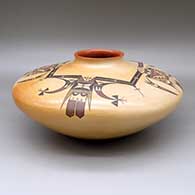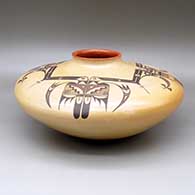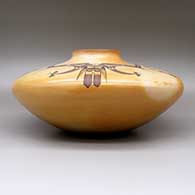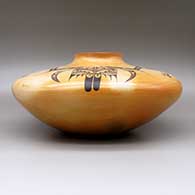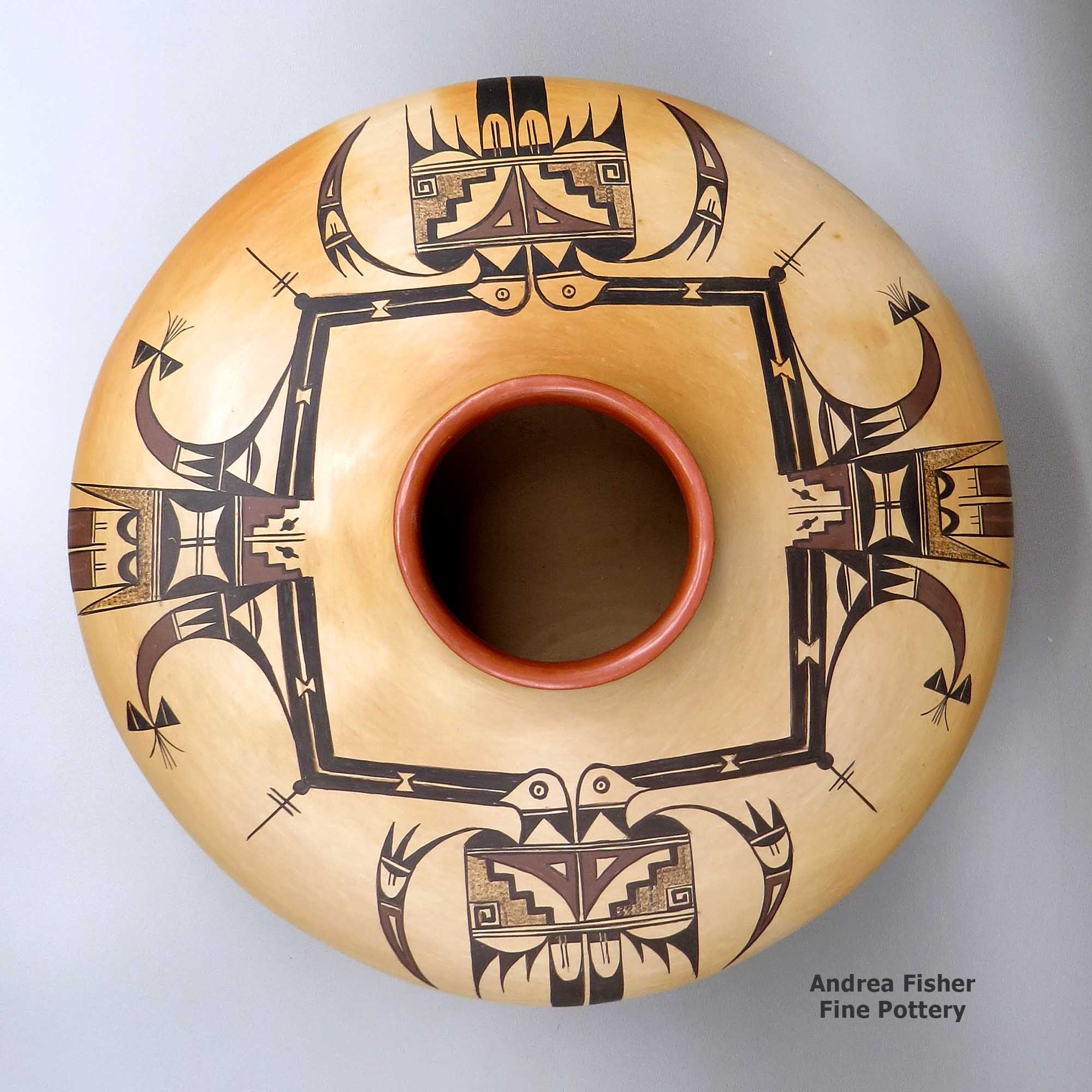
Click or tap to see a larger version
White Swann, Hopi, A polychrome Sikyatki-style jar decorated above the shoulder with a four-panel bird element, katsina and geometric design
Hopi
$ 4600
zzho3h200
A polychrome Sikyatki-style jar decorated above the shoulder with a four-panel bird element, katsina and geometric design
14.5 in L by 14.5 in W by 6.75 in H
Condition: Excellent
Signature: White Swann and her swan hallmark
Date Created: 2023
Tell me more! Buy this piece!
(505) 986-1234 - www.andreafisherpottery.com - All Rights Reserved
White Swann
Hopi
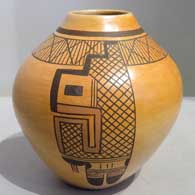
Dolly Joe White Swann Navasie was born to Eunice Navasie and Joel Nahsonhoya at Fort Defiance, Arizona in July 1964. Her grandmother was Agnes Navasie. Among her siblings were Dawn Navasie and Fawn Navasie.
Hopi
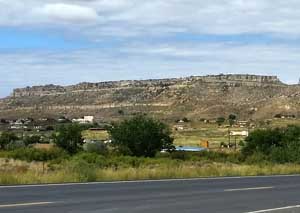
Tewa Village and First Mesa
The Hopi people live in villages on or around three mesas in northeastern Arizona. Some of these villages have been continuously occupied since the 12th century. The Hopi are not so much a "people" as a collection of clans that came together in times of drought and other misfortune. The Hopi mesas have long been seen as sanctuaries. As a result, the landscape around First Mesa is littered with the remains of villages once founded by people belonging to similar clans but speaking many different languages.
As a result, the Hopi pottery tradition is also quite varied with roots traced as far away as vitrified ceramics found in the environs of Valdivia, Ecuador, and produced between 1200 and 1500 BCE. Archaeologists excavating in the abandoned pueblos around First Mesa also found sherds of pottery styles and painted designs found in the Rio Salado region and among the ancient Sinagua settlements in the Wupatki, Tuzigoot, Walnut Canyon and Homol'ovi areas (all abandoned between about 950 and 1250 CE).
The area around Jeddito was occupied by Towa-speaking people beginning in the late 1200s. The Jeddito area is where Jeddito yellow is found, the clay that made the pottery of Sikyátki so spectacular. Beginning in the 1200s, Keres-speaking people arriving from the east began to build what became Awat'ovi, on Antelope Mesa between Jeddito and First Mesa. Sikyátki itself was also built by people from the east beginning in the early 1300s. At first Sikyátki was inhabited solely by the Kokop (Firewood) clan, then the Coyote clan came and grew to become the largest single clan in the village. Why the village was destroyed is shadowed in myth but Jesse Walter Fewkes (the first archaeologist to excavate in the area) felt the village was destroyed before the first Spanish visitor arrived in 1540. Oral history has it that Sikyátki and its people were completely wiped out but the clans that inhabited that village have somehow continued to exist. Modern dating techniques have set the destruction of Sikyátki around 1625.
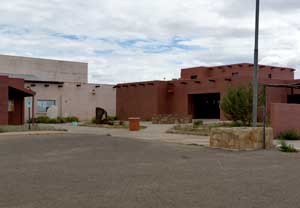
The Hopi Cultural Center
The ruins at Awat'ovi (on Antelope Mesa, east of Walpi and south of Keams Canyon) have yielded potsherds in styles and with designs that were also prominent in the prehistoric village now known as Pottery Mound (in central New Mexico). Among the potsherds found at Pottery Mound are plain and decorated Hopi products, white clay products from the Acoma-Zuni area and red clay products from north-central New Mexico. Pottery Mound was abandoned about 100 years before the Spanish arrived in New Mexico in 1540. Also similar to Pottery Mound, Awat'ovi had several kivas painted with layers of wall murals, each painted on top of the whitewashed last.
It has been reported that many of the residents of Awat'ovi were Keres-speaking people from the Four Corners area and were not as resistant as other Hopis were to the Christianizing practices of the Spanish Franciscan monks when they came into the Hopi lands around 1609. As Awat'ovi was the only pueblo in the Hopi region where a Christian mission was built, most archaeologists attribute that to the reason why residents of Walpi and Old Oraibi destroyed the village and killed nearly all its residents in the winter of 1700-1701. However, at the time of that destruction, Awat'ovi was the largest and most populous pueblo in the Hopi mesas. It was also around 1690 that the people of Walpi were relocating from their old pueblo at the foot of First Mesa to their new location atop the southernmost finger of First Mesa, a move made for defensive reasons. This was after the Pueblo Revolt of 1680 and everyone was expecting the hated Spanish to return, with more soldiers and priests.
Southern Tewa warriors and their families began arriving in the area in 1696 and were steered to take up residence at the foot of First Mesa, along the only route to the mesa top (in that location, the Tewas would be the first people to encounter incoming Spanish military - the people of Walpi felt they would make a good first line of defense should the Spanish attempt to reconquer them). The Tewas were also good at repulsing Ute, Paiute and Navajo raiders. After they won a decisive battle with Ute raiders they were allowed to build Tewa Village (also known as Hano) at the gap between the rocks on the trail up First Mesa. Some of the Tewa women were potters and in the ages-old way, they slowly shared what they knew with Hopi potters, and vice versa. That cross-pollination went on for years, and not just with pottery. Cross-cultural marriages happened, too, and today the people are known as Hopi, Hopi-Tewa and Tewa, depending on their ancestry. And while Tewa Village is completely surrounded by the Hopi Reservation, many of the residents are fluent in Tewa, Hopi and English. Some are fluent in Spanish and Navajo, too. There is a tribal injunction against any Hopi speaking Tewa: they may understand what is being spoken in Tewa but they are not allowed to speak Tewa themselves.
During those same troubled times Towa-speaking people migrated into Hopi and Navajo territory (primarily in the Jeddito Wash area) to escape the violence of the Spanish reconquest. They established familial ties that are still in place today (which may explain why Jeddito Wash is a Navajo Reservation island surrounded by the Hopi Reservation).
The village of Sichomovi was founded in the 1600s by members of the Wild Mustard Clan, Roadrunner Clan and others who'd come to the area from east of Santa Fe (Pecos Pueblo and the pueblos of the Galisteo Basin) via Zuni. They seem to have stopped at Zuni for a few years and assimilated somewhat. When they moved on to Hopi, there were quite a few Zunis among them, that's why the people of Walpi (and some from Zuni) refer to Sichomovi as a Zuni pueblo.
They arrived at Hopi around 1600 CE and became known as the Asa clan. They had traveled from the Abiquiu area through Santo Domingo, Acoma, Laguna and Zuni, picking up and dropping off people, technology and social practices along the way. Some settled at Awat'ovi while others continued to Coyote Spring (under the gap at First Mesa). They built a new pueblo where Hano now stands (it was known as Hano back then, too). A few years later drought and disease caused them to relocate again.
The quality, styles and designs of Sikyátki had lived on in Awat'ovi pottery, although the potters of Awat'ovi were also enamored of using a white slip on top of the Jeddito clay base. The potters of Awat'ovi also introduced some new designs (the "Awat'ovi star" being one) but after the village was destroyed, very little of their knowledge and practice passed on. Hopi ceramics entered a virtual Dark Age for almost 200 years.
By the mid-1800s the Hopi pottery tradition had been almost completely abandoned, its utilitarian purposes being taken over by cheap enamelware brought in by Anglo traders. Hopi pottery production sputtered along until the late 1800s when one woman, Nampeyo of Hano, almost single-handedly revived it. Nampeyo lived in Tewa Village by First Mesa and was inspired by potsherds found among the nearby ruins of Sikyátki. Today credit is given to Nampeyo for fully reviving the Sikyátki style. She was so good that Jesse Walter Fewkes, the first archaeologist to formally excavate Sikyátki, was concerned that her creations would shortly become confused with those made hundreds of years previously.
Sikyátki pottery shapes are very distinctive: flattened jars with wide shoulders; low, open bowls decorated inside; seed jars with small openings and flat tops; painting methods of splattering and stippling and very distinctive designs. The Sikyátki style originally evolved when migrant Keres and Towa-speaking potters got together with migrant Water Clan potters from the Hohokam areas of southern Arizona and northern Mexico and they began working with clays found in the Jeddito area. Over the years other clans came to the area and made their own contributions to what we now know as "Sikyátki Polychrome." Accoding to Jesse Walter Fewkes, that merging of styles, techniques and designs created some of the finest ceramics ever produced in prehistoric North America.
Today's Hopi pottery tends to be a white, yellow, orange or buff colored background decorated with designs in red and black mineral paints. Painted designs sometimes fill the entire space, often with an asymmetrical and symmetrical design. Most of the symbology painted on Hopi pottery is themed with "bird elements:" eagle tails, feathers, bird wings and migration patterns. Many Hopi, Hopi-Tewa and Tewa potters are members of the Corn Clan and their annual religious cycle revolves around the seasons of corn. The vast majority of today's Hopi pottery shapes and the designs painted on them are obvious descendants of the work of Sikyátki and Awat'ovi potters.



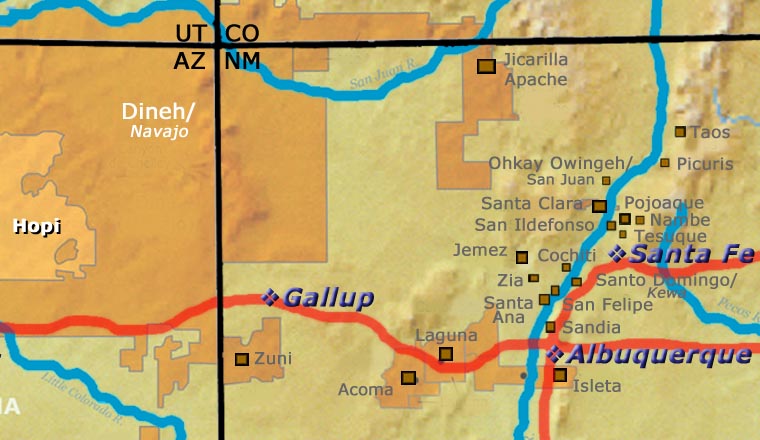
Hopi at Wikipedia
The Hopi Tribe official website
Prehistoric Hopi Pottery Designs, Jesse Walter Fewkes
Upper photos courtesy of TheArmchairExplorer, Creative Commons Attribution-ShareAlike 4.0 License
Lower photos courtesy of the Museum of New Mexico
Sikyátki Revival
Hopi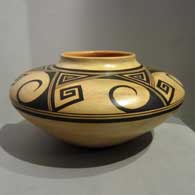
Les Namingha
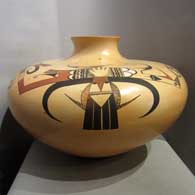
White Swann
The name "Nampeyo" has been associated with much of the pottery produced on the Hopi Reservation in northeastern Arizona since the late 1800's. The potter, Nampeyo of Hano, just happened to be the right person in the right place at the right time. She re-interpreted and re-introduced various proto-historic forms, designs and color schemes, becoming the icon of a new/old approach to the making of pottery that was quickly adopted by other potters. This new style eventually came to be known as "Sikyátki Revival Ware", as it was associated with archaeological excavations that were conducted during the 1890s at the ruins of Sikyátki, the remains of a Hopi village which had existed between about 1375 and 1625 on the east flank of First Mesa. The ruins are about three miles north of Hano at First Mesa.
The common story is that Nampeyo's husband Lesou was hired by archaeologist Jesse Walter Fewkes in 1895 to help in the excavation of Sikyátki. As Fewkes told it, Lesou told Nampeyo about the pottery he'd seen at the site and his descriptions sparked her interest. She visited the site and saw first-hand the finely made, impeccably decorated jars and bowls that were being discovered and removed. Supposedly influenced by what she saw, Nampeyo’s work began changing to emphasize highly stylized bird forms, especially macaws and eagles. She also drew inspiration from other ancestral Hopi pottery types such as Jeddito and Awatovi Black-on-Yellows.
In reality, Lesou never worked for Fewkes and Nampeyo was well known for producing high quality Sikyátki Revival ware before Fewkes ever arrived in the area. No one called it that back then but it was what local traders like Thomas Keam and Lorenzo Hubbell were asking for when potters would bring them pots for sale. They wanted shapes, colors and designs like those that littered many of the old ruins in the area. The mounds at what were Sikyátki, Awatovi and Jeddito yielded many distinctive shapes and designs, long before Fewkes arrived.
Describing Sikyátki Revival Ware (or "Hano Polychrome," to be more accurate) is difficult. The pots are uniformly polychrome, employing vegetal and mineral paints that fire to become the reds, browns, yellows and blacks that we associate with Hopi pottery these days. The designs employ graceful, curvilinear lines that are well balanced across the three-dimensional surface of the pot. The designs also frequently incorporate religious symbols. The shapes are distinctive: wide shouldered flattened jars, low bowls with decoration inside and seed jars with small openings in their centers and tops that seem to defy the laws of physics as dictated by the clay. The base clays polish and fire to an unusually smooth texture, with colors ranging from golden yellow to orange to light brown. Since the fired surface came out so smooth, no slip had to be applied to the overall surface prior to applying the designs.
The pueblos of Hopi and Zuni had developed a close relationship in the 1860's when many Hopis left the Hopi mesas during a drought and a smallpox epidemic and waited at Zuni for conditions to improve so they could return. This connection influenced Hopi potters when they saw the Zunis use a white slip under their decorations. That practice returned to Hopiland when the potters returned and it was used in the production of "Polacca Ware," the most common form of Hopi pottery being made until the late nineteenth century. Polacca Ware is characterized by a white background with a "crackled" surface.
At the encouragement of local traders Thomas Keam and Lorenzo Hubbell, some Hopis started recreating old styles and designs based on the shapes and designs implied by ancient pot shards they found among the ruins left by their ancestors. Nampeyo was among the potters who were making quantities of non-utilitarian pottery for trade purposes and she heard Keam's call. Her innovation was to abandon the use of the white slip and apply her decorations directly to the polished clay body, just as she'd observed on the ancient pots. (The Navasie/Naha families still make their pottery using the white slip but now it's called "Walpi Polychrome.")
Nampeyo was relatively prolific in her making of pots. She also had an excellent eye for design and a steady hand for painting her designs. She and her descendants have set the quality bar for Sikyátki Revival (Hano Polychrome) pottery very high and that level of quality continues to rise today.
The tremendous diversity of design and technique in modern Hopi pottery stands as testament to its long history and the care with which today's Hopi and Hopi-Tewa potters seek to preserve their heritage while continuing to innovate and evolve the medium.
Naha-Navasie Family Tree
-
Paqua Naha aka 1st Frogwoman (c. 1890-1955)
- Joy Navasie aka 2nd Frogwoman (1919-2012) & Perry Navasie
- Grace Navasie Lomaquahu (1953-) & Olson Lomaquahu
- Leona Navasie (1939-)
- Loretta Navasie Koshiway (1948-)
- Charles Navasie (1965-)
- Lana Yvonne David (1971-)
- Marianne Navasie (1951-2007) & Harrison Jim
- Donna Navasie Robertson (1972-)
- Maynard Navasie (1945-) & Veronica Navasie (1945-2003)
- Bill Navasie (1969-)
- Helen Naha aka Feather Woman (1922-1993) & Archie Naha (d. 1993)
- Burel Naha (1944-)
- Rainy Naha (1949-)
- Amber Naha (1991-)
- Tyra Naha (Tewawina) (1973-)
- Sylvia Naha Humphrey (1951-1999) Student of Helen, Rainy and Sylvia:
- Nona Naha (1958-2021) & Terry Naha
- Terran Naha
- Helen Naha & Hugh Sequi
- Cynthia Sequi Komalestewa (1954-)
- Agnes Navasie (Joy Navasie's mother-in-law)
- Eunice Fawn Navasie (c. 1920-1992) and Joel Nahsonhoya
- Dawn Navasie (1961-)
- Dolly Joe White Swann Navasie (1964-)
- Fawn Little Fawn Navasie (1959-)
- Student: Gloria Mahle
- Justin Navasie & Pauline Setalla (1930-)
- Agnes Nahsonhoya (1956-)
- Derek Nahsonhoya
- Dee Setalla (1963-)
- Gwen Setalla (1964-)
- Karen Namoki (1960-)
- Stetson Setalla (1962-)
- Agnes Nahsonhoya (1956-)
Disclaimer: This "family tree" is a best effort on our part to determine a generational order of the potters in this family. We have shown these diagrams to members of each family to get their input, too. This diagram is subject to change should we get better info. Some of the above info is drawn from Hopi-Tewa Pottery: 500 Artist Biographies, by Gregory Schaaf, © 1998, Center for Indigenous Arts & Studies.
Copyright © 1998-2025 by

